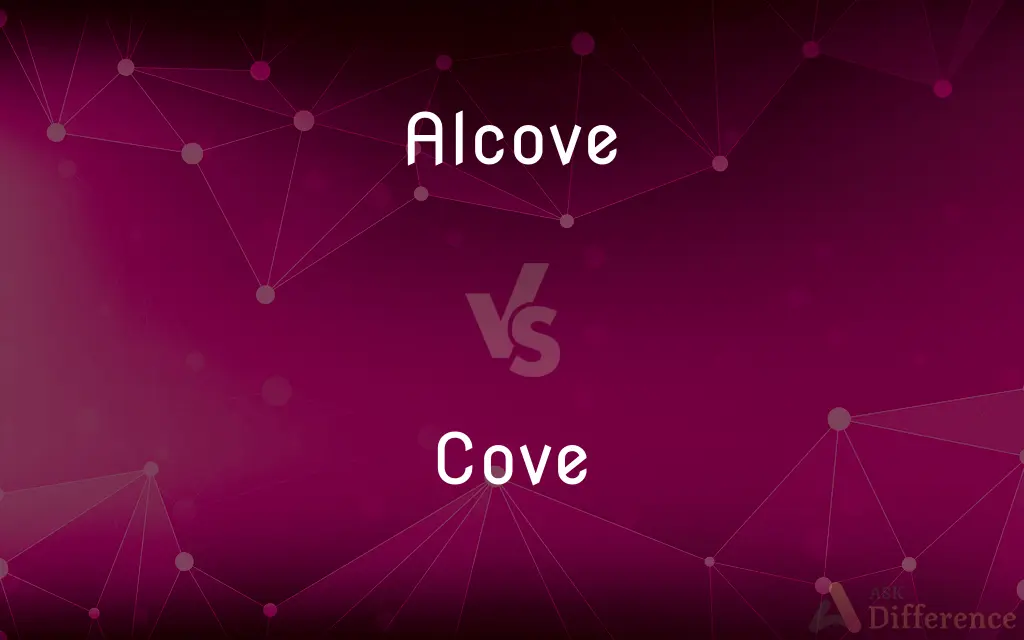Alcove vs. Cove — What's the Difference?
By Tayyaba Rehman & Maham Liaqat — Updated on March 29, 2024
An alcove is a recessed section in a room's wall, offering a cozy space, while a cove is a small, sheltered bay along a coastline.

Difference Between Alcove and Cove
Table of Contents
ADVERTISEMENT
Key Differences
An alcove is often found within indoor spaces, designed as a recess in the wall that can serve various purposes, such as a seating area or space for a bed. It is typically part of a room's architecture, adding a secluded spot without being completely separate. Whereas, a cove refers to a natural formation along a coastline, characterized by its sheltered bay area. It is formed by the erosion of softer rock, creating a small inlet often with calm waters, ideal for anchoring ships or enjoying a secluded beach.
While alcoves are man-made architectural features intended to create a semi-private or decorative space within buildings, coves are natural geographical formations. Alcoves can be custom-designed to fit specific interior design needs, including storage, seating, or display areas. On the other hand, coves are created by natural processes over time and are valued for their beauty and the shelter they provide from the sea.
Alcoves serve a functional and aesthetic purpose in interior design, offering a way to utilize space efficiently, especially in small areas. They can house bookshelves, desks, or beds, creating an intimate space. Conversely, coves are significant in ecology and maritime activities, providing habitats for diverse marine life and a safe haven for boats during bad weather.
The presence of an alcove in a home or public building can enhance the space's functionality and visual appeal, adding a unique architectural element. In contrast, coves are sought after for their scenic beauty and recreational possibilities, such as swimming, boating, and exploring marine life.
Alcoves are primarily found indoors and are a result of architectural design, while coves, being part of the natural landscape, are located outdoors along coastlines. This distinction highlights how humans interact with and adapt to their environment, creating spaces that meet their needs, whether for practical use or enjoyment of nature.
ADVERTISEMENT
Comparison Chart
Definition
A recessed section within a wall of a room or garden, offering a secluded space.
A small, sheltered bay along a coastline.
Location
Indoors, within buildings.
Outdoors, along coastlines.
Formation
Man-made, through architectural design.
Natural, through geological processes.
Purpose
To create a cozy, semi-private space for seating, sleeping, or storage.
To provide a sheltered area for boats, marine life, and recreational activities.
Characteristics
Part of a room’s architecture, can be customized.
Natural formation, characterized by calm waters and sheltered from larger bodies of water.
Compare with Definitions
Alcove
Primarily found within interior spaces of homes and public buildings.
The master bedroom features an alcove with floor-to-ceiling windows.
Cove
A small, sheltered bay along a coastline, often surrounded by hills or cliffs.
The small boat anchored in the secluded cove for the night.
Alcove
A recessed section within a room's wall, often used for seating or storage.
The alcove in the living room was the perfect spot for a reading nook.
Cove
Created by the erosion of softer rocks, leading to a sheltered inlet.
The cove’s sandy beach was hidden away from the main tourist spots.
Alcove
A design element in buildings, enhancing space utilization and aesthetics.
They added an alcove in the hallway for a built-in cabinet.
Cove
Popular for swimming, boating, and enjoying nature's tranquility.
They spent the day exploring the cove and its crystal-clear waters.
Alcove
Can be designed to fit the specific needs or style of a space.
The custom alcove shelving was a perfect solution for their book collection.
Cove
A habitat for diverse species due to its sheltered waters.
The cove was known for its vibrant coral reefs and marine biodiversity.
Alcove
Can serve various functions, from displaying art to housing additional seating.
The dining room’s alcove was transformed into a small home office.
Cove
Studied for understanding coastal erosion and sediment deposition.
Scientists surveyed the cove to study its unique geological formations.
Alcove
A recess or partly enclosed extension connected to or forming part of a room.
Cove
A cove is a small type of bay or coastal inlet. Coves usually have narrow, restricted entrances, are often circular or oval, and are often situated within a larger bay.
Alcove
A secluded structure, such as a bower, in a garden.
Cove
A small sheltered bay in the shoreline of a sea, river, or lake.
Alcove
(architecture) A small recessed area set off from a larger room.
Cove
A recess or small valley in the side of a mountain.
Alcove
A shady retreat.
The house was situated in a leafy alcove.
Cove
A cave or cavern.
Alcove
A recessed portion of a room, or a small room opening into a larger one; especially, a recess to contain a bed; a lateral recess in a library.
Cove
A narrow gap or pass between hills or woods.
Alcove
A small ornamental building with seats, or an arched seat, in a pleasure ground; a garden bower.
Cove
A concave molding.
Alcove
Any natural recess analogous to an alcove or recess in an apartment.
The youthful wanderers found a wild alcove.
Cove
A concave surface forming a junction between a ceiling and a wall. Also called coving.
Alcove
A small recess opening off a larger room
Cove
A fellow; a man.
Cove
To make in an inward curving form.
Cove
A hollow in a rock; a cave or cavern.
Cove
(architecture) A concave vault or archway, especially the arch of a ceiling.
Cove
A small coastal inlet, especially one having high cliffs protecting vessels from prevailing winds.
Cove
(US) A strip of prairie extending into woodland.
Cove
A recess or sheltered area on the slopes of a mountain.
Cove
(nautical) The wooden roof of the stern gallery of an old sailing warship.
Cove
(nautical) A thin line, sometimes gilded, along a yacht's strake below deck level.
Cove
A fellow; a man.
Cove
A friend; a mate.
Cove
(architecture) To arch over; to build in a hollow concave form; to make in the form of a cove.
Cove
To brood, cover, or sit over, as birds their eggs.
Cove
A retired nook; especially, a small, sheltered inlet, creek, or bay; a recess in the shore.
Vessels which were in readiness for him within secret coves and nooks.
Cove
A strip of prairie extending into woodland; also, a recess in the side of a mountain.
Cove
A concave molding.
Cove
A boy or man of any age or station.
There's a gentry cove here.
Now, look to it, coves, that all the beef and drinkBe not filched from us.
Cove
To arch over; to build in a hollow concave form; to make in the form of a cove.
The mosques and other buildings of the Arabians are rounded into domes and coved roofs.
Cove
To brood, cover, over, or sit over, as birds their eggs.
Not being able to cove or sit upon them [eggs], she [the female tortoise] bestoweth them in the gravel.
Cove
A small inlet
Cove
Small or narrow cave in the side of a cliff or mountain
Common Curiosities
What is the main difference between an alcove and a cove?
An alcove is a recessed section within a room's wall, primarily for architectural and functional purposes indoors, whereas a cove is a naturally formed, sheltered bay along a coastline.
Are coves safe for swimming?
Many coves, due to their sheltered nature, offer calm waters that are safer for swimming compared to open coastlines, but safety can vary based on weather and marine conditions.
What activities are commonly enjoyed in coves?
Activities in coves include swimming, snorkeling, boating, and picnicking, benefiting from the calm waters and natural shelter.
How do alcoves enhance interior design?
Alcoves add architectural interest and functionality to a room, offering space for storage, seating, or decorative displays that maximize the use of space.
Can an alcove be found outside?
Although alcoves are typically found indoors, some outdoor spaces, like gardens, may feature architectural alcoves for aesthetic or functional purposes.
What makes a cove a popular natural feature?
Coves are popular for their scenic beauty, sheltered waters, and recreational opportunities, making them ideal spots for swimming, boating, and exploring marine life.
Why are coves important to marine ecosystems?
Coves provide sheltered environments that support diverse marine ecosystems, offering safe habitats for many species and protecting them from harsher ocean conditions.
How is an alcove built?
An alcove is built as part of a building's design, often as a recessed space in a wall, planned during the architectural design phase and constructed with the rest of the building.
Are all coves small and secluded?
While many coves are small and secluded, the size and accessibility can vary greatly depending on the geographical location and coastal formation.
Can alcoves be added to an existing room?
Yes, alcoves can be added during renovations to create additional space or enhance the functionality of a room, though this may require structural modifications.
Can alcoves be used for anything other than seating or storage?
Yes, alcoves can be versatile spaces used for a variety of purposes, including sleeping areas, small offices, or even kitchen nooks.
Share Your Discovery

Previous Comparison
Alembic vs. Retort
Next Comparison
Rebellion vs. RevoltAuthor Spotlight
Written by
Tayyaba RehmanTayyaba Rehman is a distinguished writer, currently serving as a primary contributor to askdifference.com. As a researcher in semantics and etymology, Tayyaba's passion for the complexity of languages and their distinctions has found a perfect home on the platform. Tayyaba delves into the intricacies of language, distinguishing between commonly confused words and phrases, thereby providing clarity for readers worldwide.
Co-written by
Maham Liaqat














































